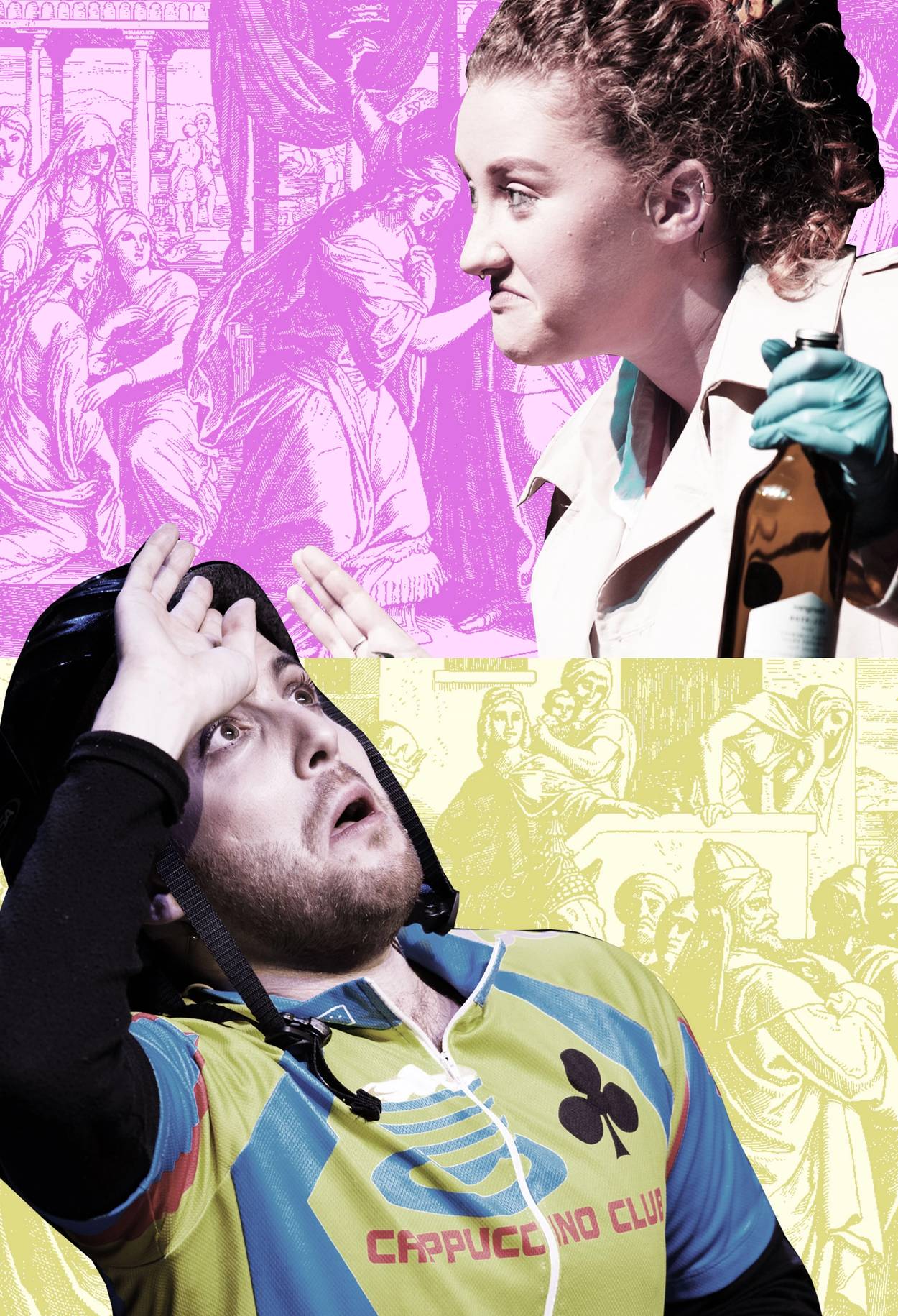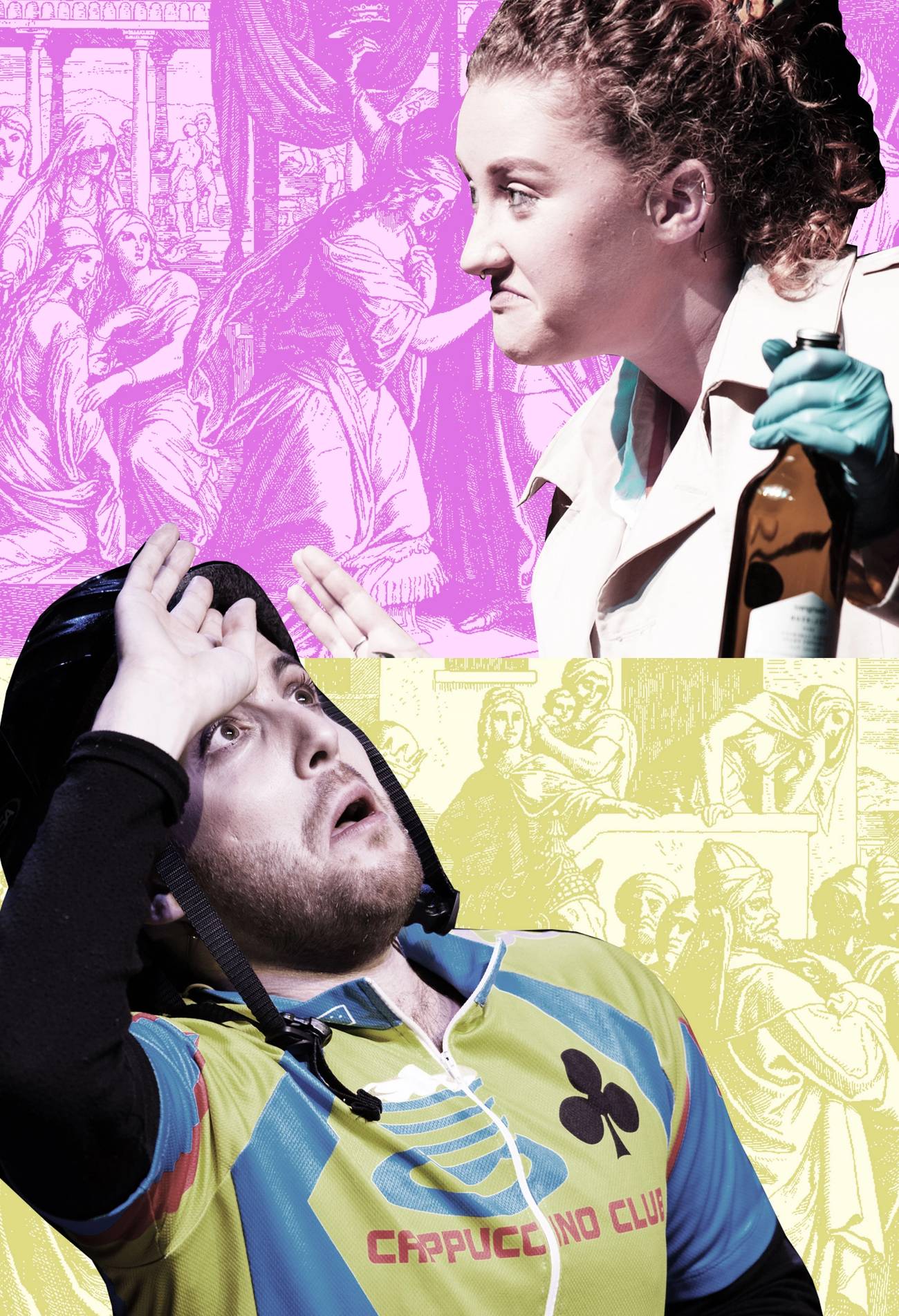Rewriting the Script
The ongoing evolution of the Purim spiel




At Temple Beth Miriam, a Reform synagogue in New Jersey, Cantor Marnie Camhi has created a niche for herself by writing and selling 11 kid-friendly Purim spiels—theatrical presentations based on the Book of Esther in the Bible. Although they ostensibly revolve around the characters in the ancient story, Purim spiels have historically provided sarcastic and incisive commentary on contemporary political and world events, often poking fun at leadership and internal Jewish problems as part of celebrating the holiday. 11
Camhi’s spiels—both musical and nonmusical—are a bit gentler. They’re always G-rated or PG-rated and are infused with references to pop culture, including such films and TV shows as Frozen, The Marvelous Mrs. Maisel, and Star Wars. Her new spiel for 2022 is called “Meta Purim” and has a social media theme. “I stay away from politics when I write my spiels,” she said. “I want them to be funny. Everybody has their own beliefs, and I want people to laugh.”
Her spiels are popular far beyond New Jersey: They are performed at synagogues and day schools across North America, Europe, and Australia. The profits from the spiels are donated to her temple.
“Each spiel is an average 30 minutes, give or take,” she explained. “They are all family-friendly and are easy to perform and very easy to adapt for any congregation’s specific need.” In Camhi’s spiels, kids are both on stage and in the audience.
Hundreds of synagogues around the world will stage all sorts of Purim spiels this year, as they do every year. They are typically performed in the weeks leading up to Purim in the evenings and afternoons or sometimes during Sunday religious school hours. Purim spiels are popular across all denominational divides, with Orthodox synagogues just as likely to stage them as Conservative or Reform congregations.
Despite their constant reinvention with the trappings of modern culture, Purim spiels are the oldest form of Jewish theater. The earliest written records of spiels date back to the 14th century—and these theatrical productions were almost certainly performed for hundreds of years prior to those first written records.
“There is a very long period of Jewish history where the Purim spiel is the only permitted form of theatrical activity,” said Debra Caplan, associate professor of theater at the City University of New York. “Jews know theater from the Greeks. So, from a Jewish perspective, the fear of theater is that it is really grounded in a fear of Hellenism taking over and assimilating Jewish life. Greek culture is grounded in polytheism and that is profoundly anti-Jewish. The rabbis write about theater as not only a tremendous threat to Jewish civilizations but also to Jewish morals.”
The festival of Purim, however, offers Jews a unique opportunity to bend the rules, insofar as it permits and encourages behavior that is not usually permissible during the year.
“There is a topsy-turviness to this holiday. Many things are permitted that are usually forbidden,” said Caplan. “In Judaism we don’t encourage drinking excessively, but on Purim this is encouraged. The rabbis did not generally allow cross-dressing, but on Purim we do. For hundreds of years, Purim was all of Jewish culture’s pent-up theatrical output that was permitted for the year.”
Historically, Purim spiels were performed in Yiddish.
“The Purim spiel emerged from Ashkenazi Jewish culture. They would never have been in Hebrew because it was not [a] holy [play]. That would have been inconceivable,” said Caplan. “They were performances for the internal Jewish community. Most of the time, the spiels weren’t for outsiders. They were for people who were part of the community and Jewish people spoke Yiddish” as their everyday language.
These days, as Yiddish is less spoken in Jewish communities around the world, the Purim spiel is generally performed in the vernacular of the performers. But Yiddish groups are spearheading a new movement to honor the Yiddish roots of the spiel. Known as the Collectif Pourim-Shpil à l’UNESCO, a group of nine Yiddish organizations in France is trying to have the Purim spiel recognized by UNESCO for its historical significance.
“Originally the project’s aim was to have the Yiddish language recognized. But UNESCO doesn’t recognize any languages,” said Helene Papiernik, from the Paris-based Yiddish group
Centre Medem-Arbeter Ring. “So, if you want patrimony recognized at UNESCO you have to find an artistic form that is unique to the culture. We found the Purim spiel, which gave birth to Yiddish cultural forms.”
So far, the project has been successful in obtaining support from the French government. But more work to support its UNESCO application is still needed.
“We need to have three countries asking UNESCO for it,” Papiernik said, adding that there are efforts underway to approach other countries to help sponsor this motion at UNESCO, with potential sponsor countries including Belgium or Canada. (Under the Trump administration, the United States left UNESCO in 2017 and is therefore currently unable to participate in such a motion.)
“In 2016, the Purim spiel was added to the French government’s Cultural Treasures list, and if UNESCO accepts it as a treasure, it will become a treasure that the whole world can then know about,” said Papiernik. “It’s a way to keep Yiddish alive.”
In Melbourne, Australia, 90-year-old Elaine Bloch remembers receiving a Purim spiel script in the mail in the 1950s from someone she knew in America. After reading through the spiel, Bloch and a small group of friends decided to perform it as a fundraiser for charity. “It was a huge success. The next year we thought we must do this again,” she recalled. “But we didn’t have another spiel script. So I wrote one.”
Bloch’s decision to write an entire Purim spiel set off a family tradition of involvement in the Purim spiel, which more than 70 years later, still endures.
Talia Boltin, Elaine’s granddaughter, took over the job of writing and producing Melbourne’s Purim spiel in 2009. “Around 1997 was the last one my grandmother did,” she said. “She ran out of energy, and there wasn’t anyone else interested in taking over in Melbourne, so it kind of died.”
A few years ago Boltin began reminiscing about the Purim spiel. “I love writing and I love theater. I started to think it was a shame that there wasn’t a Purim spiel anymore, so in 2009 I decided to bring it back. I wrote all the songs and script, I booked a theater, spoke to people, found a director, choreographer, music director, orchestra, and crew and had a cast of nine people.”
Like her grandmother’s had been, Boltin’s Purim spiel was a huge success.
“The year after we wanted to do it again, the audience loved it, and this year I am producing my 14th spiel,” she said. The songs are very eclectic too. This year the spiel is about everything from Les Miserables to Madonna and even their own version of “WAP” (spoiler: It’s about pickles). “It’s been so lovely. All these very diverse parts of the community have come together over it. I’ve really loved doing it. It’s something wonderful that we can do for tzedakah.”
Boltin’s spiels are always comedic, with a good mix of classic Yiddish humor, current affairs, and political satire thrown in. Nothing—and no one—is off-limits, from high level international affairs to the bickering at a local synagogue board. She takes an inclusive approach to all the people who audition for her spiels. “We have people with all different abilities, people with disabilities, people who have been professional opera singers previously, alongside total amateurs,” she said. “It is a really nice opportunity for people to be involved in something quite special.”
While Caplan acknowledges that people like Camhi and Boltin have been successful in producing toned down, child-friendly Purim spiels, she has a little bit of regret that today’s theatrical productions do not retain the same nuance of the original Yiddish-language spiels. “The kind of Purim spiel that we see today, in synagogue life, tends to be this very sanitized and very sort of kid-oriented retelling of the story through a familiar lens,” she said. While there is no denying that these spiels have a place, historically, Yiddish spiels were grittier as they tackled the social and political problems of the day.
“The rupture is that there is no real awareness that Purim spiels were an important source of social and political commentary,” said Caplan. “Originally, they were pitched to adults and rather sophisticated. They were deeply engaging through humor and engaged with the pressing issues of the day. I don’t think Jews know that today and that’s a tremendous loss.”
When asked what her one wish would be for the future of Purim spiels, Caplan was emphatic: “I would love to see someone retell these stories in a rich satirical form in order to wrestle with contemporary issues.”
Nomi Kaltmann is Tablet magazine’s Australian correspondent. Follow her on Twitter @NomiKal.